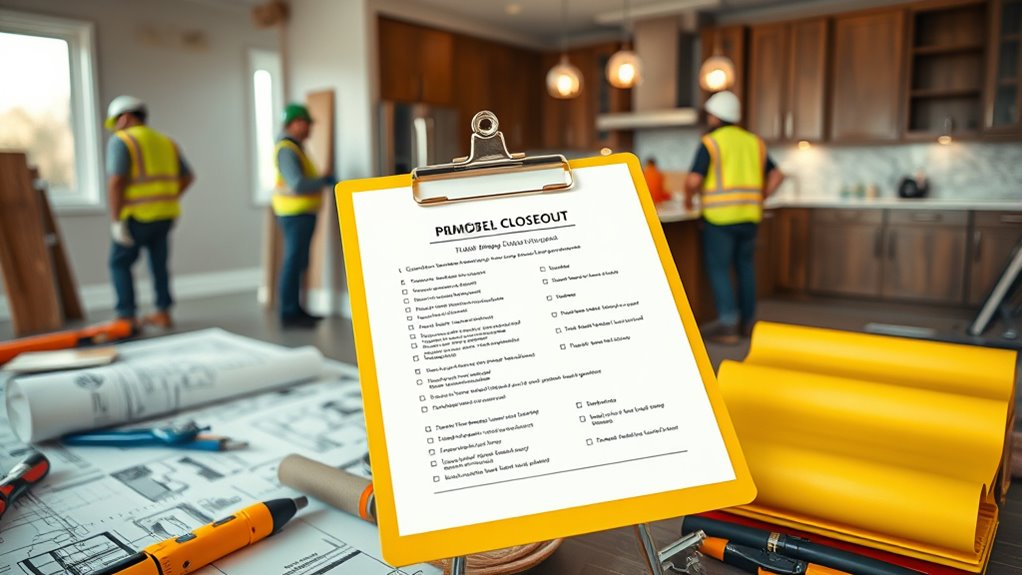Creating a detailed punch list and following a thorough closeout process guarantees your remodel ends with quality and clarity. Walk through with your contractor to identify incomplete work, safety hazards, or imperfections, and document everything precisely. Prioritize urgent items and follow up to verify they’re resolved before final approval. Organize all paperwork, warranties, and permits for a smooth closeout. Staying systematic minimizes issues and guarantees a seamless project finish—continue to explore how this approach guarantees success.
Key Takeaways
- Conduct a detailed walk-through with contractors to identify and document all remaining work and imperfections.
- Prioritize punch list items based on safety and impact, then communicate clear resolutions.
- Perform follow-up inspections to verify completion and ensure all issues are addressed before final approval.
- Finalize paperwork, warranties, and permits, ensuring all documentation is organized for closeout.
- Confirm all punch list items are resolved and the project meets quality standards before closing out.

Completing a remodel involves more than just finishing construction; it’s about guaranteeing every detail is addressed before closing out the project. This is where a well-organized punch list becomes your most valuable tool. It’s essential to systematically document every item that needs correction, touch-up, or completion, preventing overlooked issues from turning into future frustrations. As the project nears completion, take a thorough walk-through with your contractor or project manager, making detailed notes of all imperfections or incomplete work. Be specific—note whether paint touch-ups are required, fixtures need adjustment, or debris remains in certain areas. This organized approach keeps everyone on the same page and sets clear expectations for what needs to be addressed.
A thorough walk-through and detailed notes ensure all project details are finalized before closeout.
Once you have your punch list compiled, prioritize the items based on urgency and impact on the overall quality. Address safety concerns immediately, such as loose handrails or exposed wiring, before moving on to cosmetic details. Keep a detailed record of each item, including location, description, and the agreed-upon resolution. This documentation not only guides workers but also protects you if disputes arise about whether issues have been been resolved. Additionally, understanding project closeout procedures ensures you complete all necessary steps for a smooth transition. Communication is key throughout this process, so maintain regular contact with your contractor or subcontractors, ensuring they understand the scope of work remaining. Confirm deadlines for completion and verify that everyone is aligned on the expectations to avoid delays or misunderstandings.
As work progresses, conduct follow-up inspections to verify that each punch list item is completed to your satisfaction. Be diligent but fair—inspect thoroughly and provide clear feedback. If any issues are unsatisfactory, document them again and communicate directly with the responsible parties. Once all items are addressed, perform a final walk-through to ensure nothing has been overlooked. This step is crucial in confirming the project’s readiness for closeout.
The closeout process involves completing necessary paperwork, warranties, and manuals for appliances or fixtures. Make sure all inspections, permits, and approvals are finalized and documented. Keep copies of all relevant documents organized for future reference or resale. Only after confirming that every punch list item is resolved, and the paperwork is complete, should you officially close out the project. This meticulous approach guarantees a high-quality finish, minimizes post-project issues, and ensures you’re fully satisfied with your remodel. Being organized, communicative, and detail-oriented during this phase helps you achieve a seamless transition from construction to your renewed space.
Frequently Asked Questions
How Long Does the Punch List Process Typically Take?
The punch list process usually takes between one to two weeks, depending on project size and complexity. You should expect to review the list with your contractor promptly after completion, ensuring all issues are documented clearly. Once the list is finalized, the contractor typically has a few days to address the items. Staying organized and maintaining open communication speeds up the process, helping you achieve a smooth project closeout.
Who Is Responsible for Creating the Punch List?
You are responsible for creating the punch list, but it’s a collaborative effort. You should involve the contractor, project manager, and sometimes the client to guarantee all items are accurately documented. You’ll walk through the space, note incomplete or unsatisfactory work, and prioritize issues. Clear communication is essential, so organize the list systematically, specify details, and confirm everyone understands the scope before finalizing it for timely completion.
Can Minor Issues Be Deferred to Future Maintenance?
You can defer minor issues to future maintenance, but think of your project as a finely tuned machine; neglecting small glitches may cause bigger problems down the road. Clearly document these issues, prioritize them based on urgency, and communicate with your contractor to set expectations. Regular inspections help catch minor problems early, ensuring they don’t fester into costly repairs later. Staying organized keeps your remodel running smoothly and efficiently.
What if There Are Disagreements Over Punch List Items?
If you face disagreements over punch list items, you should document each issue clearly and communicate openly with your contractor. Review the contract specifications and photos to support your position. Schedule a meeting to discuss concerns, aiming for mutual understanding. If disagreements persist, consider involving a third-party mediator or inspector to provide an objective opinion. Staying organized and respectful helps resolve disputes efficiently, ensuring the project closes smoothly.
How Does the Closeout Process Impact Warranty Coverage?
The closeout process directly impacts your warranty coverage by officially documenting completed work and identifying any outstanding issues. This guarantees you understand what’s covered and when, providing clarity and protection. During closeout, all punch list items are addressed, and warranties are transferred or issued. Staying organized and detailed helps prevent future disputes, giving you peace of mind that your remodel is protected and warranty claims are straightforward if problems arise.
Conclusion
As you wrap up your remodel, think of the punch list as your final brushstroke, adding clarity and precision to your masterpiece. Staying organized and communicative guarantees nothing slips through the cracks, transforming chaos into a well-orchestrated symphony of completion. When the last item is checked off, you’ll feel the satisfaction of a project brought to life with meticulous care. Embrace this closeout phase—it’s the finishing touch that turns a good remodel into a great one.









